Europe, British Isles, South-East England, Hampshire, Winchester Cathedral [Map]
Winchester Cathedral is in Winchester, Hampshire [Map].
1043 Coronation of Edward the Confessor
1189 Richard I Appoints his Bishops
1189 Oct New Bishops Consecrated
1486 Birth and Christening of Arthur Prince of Wales
Choir of Winchester Cathedral [Map].
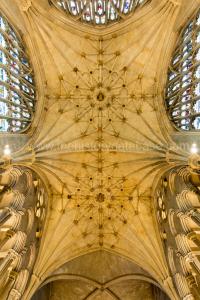
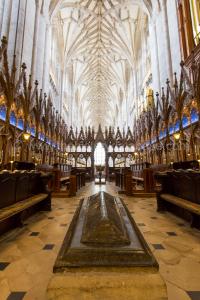
North Aisle of Winchester Cathedral [Map].
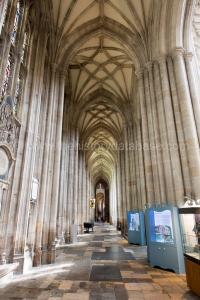
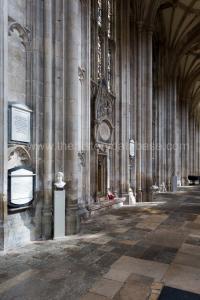
Anglo-Saxon Chronicle. 643. This year Kenwal succeeded to the kingdom of the West-Saxons, and held it one and thirty winters. This Kenwal ordered the old20 church at Winchester [Map] to be built in the name of St. Peter. He was the son of Cynegils.
Note 20. This epithet appears to have been inserted in some copies of the "Saxon Chronicle" so early as the tenth century; to distinguish the "old" church or minster at Winchester from the "new", A.D. 903.
Before 660 Bishop Wine of London was consecrated 1st Bishop of Winchester.
Bede. 673. Eleutherius was the fourth bishop of the West Saxons; for Birinus was the first, Agilbert the second, and Wine the third. When Coinwalch, in whose reign the said Eleutherius was made bishop, died, his under-rulers took upon them the kingdom of the people, and dividing it among themselves, held it ten years; and during their rule he died, and Heddi succeeded him in the bishopric, having been consecrated by Theodore (age 71), in the city of London; during whose prelacy, Cadwalla (age 14), having subdued and removed those rulers, took upon him the government. When he had reigned two years, and whilst the same bishop still governed the church, he quitted his sovereignty for the love of the heavenly kingdom, and, going away to Rome, ended his days there, as shall be said more fully hereafter.
Around 676 Bishop Hædde was appointed Bishop of Winchester.
In 676 Bishop Hedda was appointed Bishop of Winchester.
Anglo-Saxon Chronicle. 703. This year died Bishop Hedda, having held the see of Winchester twenty-seven winters.
Bede. 705. How the South Saxons received Eadbert and Eolla and the West Saxons Daniel and Aldhelm for their bishops; and of the writings of the same Aldhelm. [705 a.d.]
In the year of our Lord 705, Aldfrid, king of the Northumbrians, died before the end of the twentieth year of his reign. His son Osred (age 8), a boy about eight years of age, succeeding him in the throne, reigned eleven years. In the beginning of his reign, Haedde, bishop of the West Saxons, departed to the heavenly life; for he was a good man and a just, and his life and doctrine as a bishop were guided rather by his innate love of virtue, than by what he had gained from books. The most reverend bishop, Pechthelm, of whom we shall speak hereafter in the proper place, and who while still deacon or monk was for a long time with his successor Aldhelm (age 66), was wont to relate that many miracles of healing have been wrought in the place where he died, through the merit of his sanctity; and that the men of that province used to carry the dust thence for the sick, and put it into water, and the drinking thereof, or sprinkling with it, brought health to many sick men and beasts; so that the holy dust being frequently carried away, a great hole was made there.
Upon his death, the bishopric of that province was divided into two dioceses. One of them was given to Daniel, which he governs to this day; the other to Aldhelm (age 66), wherein he presided most vigorously four years; both of them were fully instructed, as well in matters touching the Church as in the knowledge of the Scriptures. Aldhelm (age 66), when he was as yet only a priest and abbot of the monastery which is called the city of Maildufus [Map], by order of a synod of his own nation, wrote a notable book against the error of the Britons, in not celebrating Easter at the due time, and in doing divers other things contrary to the purity of doctrine and the peace of the church; and through the reading of this book many of the Britons, who were subject to the West Saxons, were led by him to adopt the Catholic celebration of our Lord's Paschal Feast. He likewise wrote a famous book on Virginity, which, after the example of Sedulius, he composed in twofold form, in hexameters and in prose. He wrote some other books, being a man most instructed in all respects, for he had a polished style, and was, as I have said, of marvellous learning both in liberal and ecclesiastical studies. On his death, Forthere was made bishop in his stead, and is living at this time, being likewise a man very learned in the Holy Scriptures.
Whilst they administered the bishopric, it was determined by a synodal decree, that the province of the South Saxons, which till that time belonged to the diocese of the city of Winchester, where Daniel then presided, should itself have an episcopal see, and a bishop of its own. Eadbert, at that time abbot of the monastery [Map] of Bishop Wilfrid, of blessed memory, called Selaeseu [Map], was consecrated their first bishop. On his death, Eolla succeeded to the office of bishop. He also died some years ago, and the bishopric has been vacant to this day.
In 705 Bishop Daniel of Winchester was appointed Bishop of Winchester.
In 744 Bishop Hunferth of Winchester was consecrated Bishop of Winchester.
Anglo-Saxon Chronicle. 744. This year Daniel resigned the see of Winchester; to which Hunferth was promoted. The stars went swiftly shooting; and Wilferth the younger, who had been thirty winters Bishop of York [Note. Probably a mistake for Worcester], died on the third day before the calends of May.
In 756 Bishop Cyneheard of Winchester was consecrated Bishop of Winchester.
On 30 Oct 852 Bishop Swithun was consecrated Bishop of Winchester.
Between 878 and 879 Bishop Denewulf was appointed Bishop of Winchester.
In 909 Bishop Frithestan was appointed Bishop of Winchester.
Anglo-Saxon Chronicle. 910. This year Frithestan took to the bishopric of Winchester; and Asser died soon after, who was Bishop of Sherborne. The same year King Edward (age 36) sent an army both from Wessex and Mercia, which very much harassed the northern army by their attacks on men and property of every kind. They slew many of the Danes, and remained in the country five weeks. This year the Angles and the Danes fought at Tootenhall; and the Angles had the victory. The same year Ethelfleda (age 40) built the fortress at Bramsbury.
In May 931 Bishop Beornstan was consecrated Bishop of Winchester.
Anglo-Saxon Chronicle. 932. This year Burnstan was invested Bishop of Winchester on the fourth day before the calends of June; and he held the bishopric two years and a half.
Anglo-Saxon Chronicle. 935. This year Bishop Elfheah took to the bishopric of Winchester.
In 935 Bishop Ælfheah "The Bald" was elected Bishop of Winchester.
Anglo-Saxon Chronicle. 963. This year died Wulfstan, the deacon, on Childermass-day;42 and afterwards died Gyric, the mass-priest. In the same year took Abbot Athelwold (age 59) to the bishopric of Winchester; and he was consecrated on the vigil of St. Andrew, which happened on a Sunday. On the second year after he was consecrated, he made many minsters; and drove out the clerks43 from the bishopric, because they would hold no rule, and set monks therein. He made there two abbacies; one of monks, another of nuns. That was all within Winchester. Then came he afterwards to King Edgar (age 20), and requested that he would give him all the minsters that heathen men had before destroyed; for that he would renew them. This the king cheerfully granted; and the bishop came then first to Ely [Map], where St. Etheldritha lies, and ordered the minster to be repaired; which he gave to a monk of his, whose name was Britnoth, whom he consecrated abbot: and there he set monks to serve God, where formerly were nuns. He then bought many villages of the king, and made it very rich. Afterwards came Bishop Athelwold (age 59) to the minster called Medhamsted, which was formerly ruined by heathen folk; but he found there nothing but old walls, and wild woods. In the old walls at length he found hid writings which Abbot Hedda (age 59) had formerly written;-how King Wulfhere and Ethelred his brother had wrought it, and how they freed it against king and against bishop, and against all worldly service; and how Pope Agatho confirmed it with his writ, as also Archbishop Deusdedit. He then ordered the minster to be rebuilt; and set there an abbot, who was called Aldulf; and made monks, where before was nothing. He then came to the king, and let him look at the writings which before were found; and the king then answered and said: "I Edgar grant and give to-day, before God and before Archbishop Dunstan (age 54), freedom to St. Peter's minster at Medhamsted, from king and from bishop; and all the thorps that thereto lie; that is, Eastfield, and Dodthorp, and Eye, and Paston. And so I free it, that no bishop have any jurisdiction there, but the abbot of the minster alone. And I give the town called Oundle, Northamptonshire [Map], with all that thereto lieth, called Eyot-hundred, with market and toll; so freely, that neither king, nor bishop, nor earl, nor sheriff, have there any jurisdiction; nor any man but the abbot alone, and whom he may set thereto. And I give to Christ and St. Peter, and that too with the advice of Bishop Athelwold (age 59), these lands;-that is, Barrow, Warmington, Ashton, Kettering, Castor, Eylesworth, Walton, Witherington, Eye, Thorp, and a minster at Stamford. These lands and al the others that belong to the minster I bequeath clear; that is, with sack and sock, toll and team, and infangthief; these privileges and all others bequeath I clear to Christ and St. Peter. And I give the two parts of Whittlesey-mere, with waters and with wears and fens; and so through Meerlade along to the water that is called Nen; and so eastward to Kingsdelf. And I will that there be a market in the town itself, and that no other be betwixt Stamford and Huntingdon. And I will that thus be given the toll;-first, from Whittlesey-mere to the king's toll of Norman-cross hundred; then backward again from Whittlesey-mere through Meerlade along to the Nen, and as that river runs to Crowland; and from Crowland to Must, and from Must to Kingsdelf and to Whittlesey-mere. And I will that all the freedom, and all the privileges, that my predecessors gave, should remain; and I write and confirm this with the rood-token of Christ." (+)-Then answered Dunstan, the Archbishop of Canterbury, and said: "I grant, that all the things that here are given and spoken, and all the things that thy predecessors and mine have given, shall remain firm; and whosoever breaketh it, then give I him God's curse, and that of all saints, and of all hooded heads, and mine, unless he come to repentance. And I give expressly to St. Peter my mass-hackle, and my stole, and my reef, to serve Christ." "I Oswald, Archbishop of York, confirm all these words through the holy rood on which Christ was crucified." (+) "I Bishop Athelwold (age 59) bless all that maintain this, and I excommunicate all that break it, unless they come to repentance."-Here was Bishop Ellstan, Bishop Athulf, and Abbot Eskwy, and Abbot Osgar, and Abbot Ethelgar, and Alderman Elfere; Alderman Ethelwin, Britnoth and Oslac aldermen, and many other rich men; and all confirmed it and subscribed it with the cross of Christ. (+) This was done in the year after our Lord's Nativity 972, the sixteenth year of this king. Then bought the Abbot Aldulf lands rich and many, and much endowed the minster withal; and was there until Oswald, Archbishop of York, was dead; and then he was chosen to be archbishop. Soon after another abbot was chosen of the same monastery, whose name was Kenulf, who was afterwards Bishop of Winchester. He first made the wall about the minster, and gave it then the name of Peterborough, which before was Medhamsted. He was there till he was appointed Bishop of Winchester, when another abbot was chosen of the same monastery, whose name was Elfsy, who continued abbot fifty winters afterwards. It was he who took up St. Kyneburga and St. Kyneswitha, that lay at Castor, and St. Tibba, that lay at Ryhall; and brought them to Peterborough, and offered them all to St. Peter in one day, and preserved them all the while he was there.
i.e. the secular clergy, who observed no rule; opposed to the regulars, or monks.
Note 42. i.e. the feast of the Holy Innocents; a festival of great antiquity.
Note 43. i.e. the secular clergy, who observed no rule; opposed to the regulars, or monks.
Before 29 Nov 963 Bishop Æthelwold (age 59) was elected Bishop of Winchester.
On 29 Nov 963 Bishop Æthelwold (age 59) was consecrated Bishop of Winchester.
On 14 Oct 984 Archibishop Ælfheah (age 31) was consecrated Bishop of Winchester.
On 28 Oct 984 Archibishop Ælfheah (age 31) was enthroned Bishop of Winchester.
In 1006 Bishop Ælfheah was elected Bishop of Winchester.
In 1032 Bishop Ælfwine was appointed Bishop of Winchester.
On 03 Apr 1043 King Edward "Confessor" of England (age 40) was crowned King England at Winchester Cathedral [Map] by Archbishop Eadsige.
Anglo-Saxon Chronicle. 03 Apr 1043. This year was Edward (age 40) consecrated king at Winchester [Map], early on Easter-day, with much pomp. Then was Easter on the third day before the nones of April. Archbishop Edsy consecrated him, and before all people well admonished him. And Stigand the priest was consecrated bishop over the East Angles. And this year, fourteen nights before the mass of St. Andrew, it was advised the king, that he and Earl Leofric and Earl Godwin (age 42) and Earl Siward (age 33) with their retinue, should ride from Gloucester to Winchester unawares upon the lady (age 58); and they deprived her of all the treasures that she had; which were immense; because she was formerly very hard upon the king her son, and did less for him than he wished before he was king, and also since: but they suffered her to remain there afterwards. And soon after this the king determined to invest all the land that his mother (age 58) had in her hands, and took from her all that she had in gold and in silver and in numberless things; because she formerly held it too fast against him. Soon after this Stigand was deprived of his bishopric; and they took all that he had into their hands for the king, because he was highest the counsel of his mother; and she acted as he advised, as men supposed.
Before 1075 Richard Normandy (age 21) was killed whilst hunting at New Forest, Hampshire. He was buried at Winchester Cathedral [Map].
On 03 Aug 1100 Bishop William Giffard was appointed Bishop of Winchester.
In 1129 Bishop Henry of Blois (age 31) was appointed Bishop of Winchester.
On 27 Aug 1172 Henry the Young King (age 17) and Margaret Capet (age 15) were married at Winchester Cathedral [Map]. Margaret's dowry included the Vexin; the border between France and Normandy. On the same day they were both crowned by Rotrou Newburgh Archbishop Rouen. She the daughter of Louis VII King Franks (age 52) and Constance of Castile. He the son of King Henry "Curtmantle" II of England (age 39) and Eleanor of Aquitaine Queen Consort Franks and England (age 50). They were half fourth cousins.



On 15 Sep 1189 King Richard "Lionheart" I of England (age 32) held a Council meeting at Pipewell [Map] at which he appointed a number of Bishops:
Bishop William Longchamp was elected Bishop of Ely.
Bishop Godfrey Lucy was elected Bishop of Winchester.
Bishop Richard Fitzneal (age 59) was elected Bishop of London.
Archbishop Hubert Walter (age 29) was elected Bishop of Salisbury.
On 22 Oct 1189 two of Richard's new Bishops were consecrated ...
Bishop Godfrey Lucy was consecrated Bishop of Winchester.
Archbishop Hubert Walter (age 29) was consecrated Bishop of Salisbury.
On 11 Mar 1194 King Richard "Lionheart" I of England (age 36) was re-crowned I King England at Winchester Cathedral [Map]. Bishop William de Vere was present.

Around Mar 1205 Bishop Peter de Roches was elected Bishop of Winchester.
On 24 Mar 1206 Bishop Peter de Roches was consecrated Bishop of Winchester.
In 1240 Bishop Aymer de Valence (age 18) was appointed Bishop of Winchester.
Monumental Effigies. Bishop de Rupibus in Winchester Cathedral [Map]. Peter de Roches latinised as Peter de Rupibus ie Peter from the rocks.
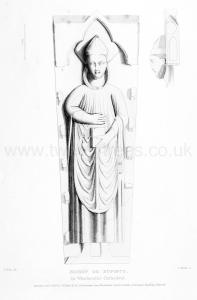
On 02 Mar 1268 Bishop Nicholas Ely was translated to Bishop of Winchester at Worcester Cathedral [Map] by Pope Clement IV.
On 27 May 1268 Bishop Nicholas Ely was enthroned as Bishop of Winchester at Winchester Cathedral [Map].
In Oct 1366 Bishop William of Wykeham (age 46) was elected Bishop of Winchester.
On 10 Oct 1367 Bishop William of Wykeham (age 47) was consecrated Bishop of Winchester at St Paul's Cathedral [Map].
In Jul 1368 Bishop William of Wykeham (age 48) was enthroned Bishop of Winchester at Winchester Cathedral [Map].
On 27 Sep 1404 Bishop William of Wykeham (age 84) died at Bishop's Waltham [Map]. He was buried in a chantry chapel on the south side of Winchester Cathedral [Map].
On 19 Nov 1404 Cardinal Henry Beaufort (age 29) was appointed Bishop of Winchester.
On 11 Apr 1447 Cardinal Henry Beaufort (age 72) died at Wolvesey Castle [Map]. He was buried in his Chantry Chapel at Winchester Cathedral [Map].
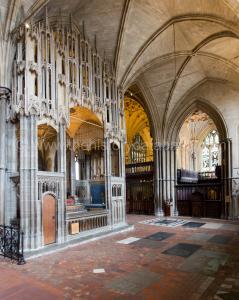
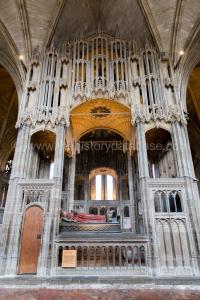
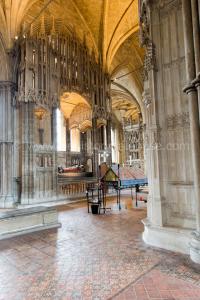
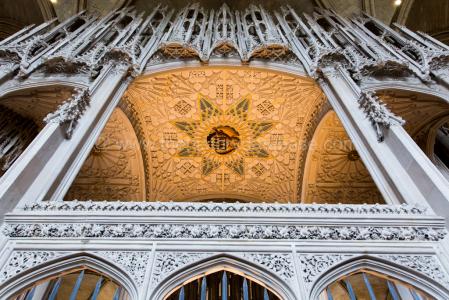
On 13 Jul 1447 Bishop William Waynflete (age 49) was consecrated Bishop of Winchester.
On 11 Aug 1486 Bishop William Waynflete (age 88) died. He was buried at Winchester Cathedral [Map] where he has a Chantry Chapel.
On 24 Sep 1486 Prince Arthur Tudor was christened at Winchester Cathedral [Map] by Bishop John Alcock (age 56).
Cecily "Rose of Raby" Neville Duchess York (age 71) held the child. His godparents included Thomas Stanley 1st Earl of Derby (age 51), William Fitzalan 16th Earl Arundel (age 68), John de Vere 13th Earl of Oxford (age 44), Thomas Fitzalan 17th Earl Arundel (age 36), Elizabeth Woodville Queen Consort England (age 49) and Cecily York Viscountess Welles (age 17).





Richard Woodville 3rd Earl Rivers (age 33) was present.
Before 16 Oct 1486 Bishop Robert Morton (age 51) was appointed Archdeacon Winchester.
In 1487 Bishop Peter Courtenay was appointed Bishop of Winchester.
In 1493 Bishop Thomas Langton was translated to Bishop of Winchester.
In Aug 1501 Bishop Richard Foxe (age 53) was elected Bishop of Winchester.
On 05 Oct 1528 Bishop Richard Foxe (age 80) died at Wolvesey Castle [Map]. He was buried at Winchester Cathedral [Map] where he has a Chantry Chapel.
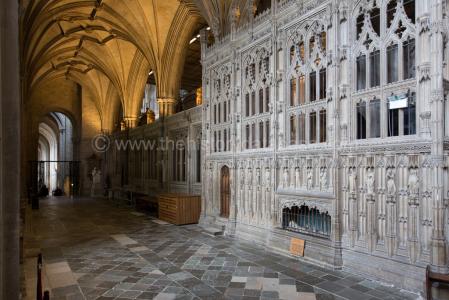
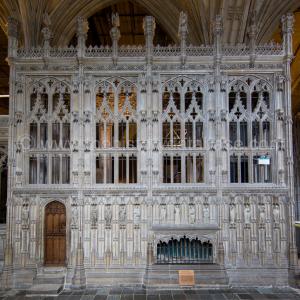
In 1531 Bishop Stephen Gardiner (age 48) was appointed Bishop of Winchester.
On 18 Sep 1535 Bishop John Hilsey was consecrated Bishop of Rochester by Archbishop Thomas Cranmer (age 46) at Winchester Cathedral [Map].
In 1549 John Mason (age 46) was elected Dean of Winchester which position he held until 1554.
On 08 Mar 1551 Bishop John Ponet (age 37) was elected Bishop of Winchester.
In 1553 Bishop Stephen Gardiner (age 70) was appointed Bishop of Winchester.
Wriothesley's Chronicle 23 Jul 1554. 23 Jul 1554. The 23 of Julie the Prince of Spayne (age 27) came to Winchesterd about vi of the clock at night, accompanied with noblemen as well of England as of his owne countriea, with trumpetts blowinge and bells ringinge, and came to the Cathedrall [Map] churche, where he alighted. And there the Bishop of Winchester, Lord Chauncellor (age 71), with 4 bishops more, with the priests, singinge-men, and children, receaved him with procession in riche copes and with iii crosses up into the quiere, where was a riche traves richlye hanged for him; and there he kneeled downe before the sacrament; and then the Lord Chauncellor began Te Deum, the organs playinge and the quier singinge the rest. This done he was brought out with torche light to his lodginge throughe the cloyster to the Deanes howsse, all the Queens garde standinge in their riche cotes all the waye. He was apparelled in a riche cote richlie imbroydered with goulde, and an hatt much like the same with a feather in it. The same night after he had supped, which was about x of the clock, certeyne of the Councell brought him to the Queen (age 38) by a secrett waye, where she receaved him right lovinglye and kissed him, and after halfe an howre they tooke their leave, eche kissinge the other, and so departed that night to his lodginge.
Note d. Philip lingered a few days at Southampton, where he disembarked, as if in order to ascertain the humour of the nation, as one of his ambassadors, the Count of Egmont (age 31), had been recently violently assaulted by the populace, who mistook him for his master.
Note a. He came well attended with a bodyguard and troops.
On 25 Jul 1554 Prince Philip of Spain (age 27) and Queen Mary (age 38) were married by Bishop Stephen Gardiner (age 71) at Winchester Cathedral [Map]. She the daughter of King Henry VIII of England and Ireland and Catherine of Aragon Queen Consort England. He the son of Charles V Holy Roman Emperor (age 54) and Isabel Aviz Queen Consort Spain. They were first cousin once removed. He a great x 5 grandson of King Edward III of England. 


John Gage (age 74) bore the queen's train.
Magdalen Dacre Viscountess Montague (age 16) took part in the Bridal Procession.
In 1556 Bishop John White (age 46) was appointed Bishop of Winchester.
On 28 Feb 1556 Bishop Stephen Gardiner was buried at Winchester Cathedral [Map].
In 1559 Bishop John White (age 49) was deprived of his see of Bishop of Winchester and imprisoned.
In 1560 Bishop Robert Horne (age 49) was consecrated Bishop of Winchester.
Henry Machyn's Diary. 15 Jan 1560. The xv day of January was cared to be bered master doctor Whyt (deceased), late byshope of Wynchester, unto Wynchester [Map], and bered ther.
Note. P. 224. Funeral of the late bishop of Winchester. John White, warden of Winchester college, consecrated bishop of Lincoln 1554 (see p. 58), translated to Winchester 1556, deprived 1559. He was brother to alderman sir John White, to whose house he had been allowed to repair on coming out of the Tower (see p. 203), this being an instance (to which there are many parallels) of two brothers bearing the same Christian name. Sir Thomas White, of South Warnborough, Hampshire, was his brother-in-law, for, though not nearly related in paternal descent, there had been two marriages which connected the families, sir Thomas White having married Agnes sister to the bishop and sir John, and sir John having married for his first wife Sibell sister of sir Thomas White. See the Collectanea Topogr. et Geneal. vol. vii. p. 212.
Before 29 Feb 1560 Bishop James Pilkington (age 40) was elected Bishop of Winchester but he declined the post.
Henry Machyn's Diary. 29 Feb 1560. The xxix of Feybruary was bered in sant Martens parryche the wyff (age 40) of master (blank) Cage (age 45) sarter [salter], and he gayff xx ... gownes and xij mantyll frys gownes unto xij pore women, and xij clarkes syngyng; and master Pylkyngton (age 40) dyd pryche, the nuw byshope of Wynchastur [Note. He was elected Bishop of Winchester but he declined it. He was subsequently elected Bishop of Durham], and after a dolle of money, a j d. a-pesse.
Henry Machyn's Diary. 19 Nov 1560. The xix day of November was electyd the byshope of Wynchester at the cowrt, master Horne (age 50) late dene of Durram.
In 1595 Bishop William Wickham (age 56) was appointed Bishop of Winchester.
In 1596 Bishop Thomas Bilson (age 49) was appointed Bishop of Winchester.
In 1597 Bishop Thomas Bilson (age 50) was appointed Bishop of Winchester for which he paid Queen Elizabeth I of England and Ireland (age 63) an annuity of £400.
On 19 Mar 1602 Robert Burgh 10th Baron Cobham 8th Baron Strabolgi 4th Baron Burgh (deceased) was buried at Winchester Cathedral [Map].
On 03 Jul 1616 Bishop James Montagu (age 48) was translated to Bishop of Winchester.
In Feb 1619 Bishop Lancelot Andrewes (age 64) was translated to Bishop of Winchester.
In 1628 Richard Neale Archbishop (age 65) was elected Bishop of Winchester.
Evelyn's Diary. 03 Oct 1642. To Chichester [Map], and hence the next day to see the Siege of Portsmouth; for now was that bloody difference between the King and Parliament broken out, which ended in the fatal tragedy so many years after. It was on the day of its being rendered to Sir William Waller (age 45); which gave me an opportunity of taking my leave of Colonel Goring (age 34), the governor, now embarking for France. This day was fought that signal battle at Edgehill. Thence I went to Southampton, Hampshire [Map] and Winchester, Hampshire [Map], where I visited the castle, school, church, and King Arthur's Round Table; but especially the church [Map], and its Saxon kings' monuments, which I esteemed a worthy antiquity.
In 1660 Bishop Brian Duppa (age 70) was elected Bishop of Winchester.
In 1662 Bishop George Morley (age 63) was translated to Bishop of Winchester.
In 1679 Richard Meggot was appointed Dean of Winchester.
Evelyn's Diary. 06 Jul 1679. There was now brought up to London a child, son of one Mr. Wotton, formerly amanuensis to Dr. Andrews, Bishop of Winton, who both read and perfectly understood Hebrew, Greek, Latin, Arabic, Syriac, and most of the modern languages; disputed in divinity, law, and all the sciences; was skillful in history, both ecclesiastical and profane; in politics; in a word, so universally and solidly learned at eleven years of age, that he was looked on as a miracle. Dr. Lloyd (age 42), one of the most deeply learned divines of this nation in all sorts of literature, with Dr. Burnet (age 35), who had severely examined him, came away astonished, and they told me they did not believe there had the like appeared in the world. He had only been instructed by his father, who being himself a learned person, confessed that his son knew all that he himself knew. But, what was more admirable than his vast memory, was his judgment and invention, he being tried with divers hard questions, which required maturity of thought and experience. He was also dexterous in chronology, antiquities, mathematics. In sum, an intellectus universalis, beyond all that we read of Picus Mirandula, and other precocious wits, and yet withal a very humble child.
In 1684 Bishop Peter Mews (age 64) was elected Bishop of Winchester.
Evelyn's Diary. 07 Mar 1684. Dr. Meggot, Deane of Winchester, preached an incomparable sermon, (the King (age 53) being now gone to Newmarket,) on 12 Heb. 15. shewing and pathetically pressing the care we ought to have least we come short of the grace of God. Afterwards I went to visite Dr. Tenison (age 47) at Kensington, whither he was retired to refresh after he had ben sick of the smallpox.
Evelyn's Diary. 16 Sep 1685. Hence I went to see the Cathedral [Map], a reverend pile, and in good repaire. There are still the coffins of the six Saxon Kings, whose bones had ben scatter'd by the sacrilegious Rebells of 1641, in expectation, I suppose, of finding some valuable reliques, and afterwards gather'd up againe and put into new chests, wch stand above the stalls of the Choir.
Evelyn's Diary. 08 Jul 1686. Dr. Meggot, Dean of Winchester preached before the household in St. George's Chapel [Map] at Windsor, the late King's glorious chapel now seized on by the mass priests. Dr. Cartwright (age 52), Dean of Ripon, preached before the great men of the Court in the same place.
Evelyn's Diary. 03 Mar 1687. Dr. Meggott, Dean of Winchester, preached before the Princess of Denmark (age 22), on Matt. xiv. 23. In the afternoon, I went out of town to meet my Lord Clarendon, returning from Ireland.

In 1696 Bishop Welbore Ellis (age 45) was appointed Prebendary of Winchester.
In 1707 Bishop Jonathan Trelawny 3rd Baronet (age 56) was appointed Bishop of Winchester.
On 31 Oct 1769 Reverend Newton Ogle (age 43) was appointed Dean of Winchester which office he held until his death 1804.
Vesta Monumenta. 1786. Plates 2.39 and 2.40. Twelfth-century baptismal font in Winchester Cathedral [Map]. Carved of a blue-black limestone commonly known as "Tournai marble," the north and east sides of this font depict eight birds and a mammal, and the south and west sides present hagiographical scenes from the life of St. Nicholas of Myra (also known as "Saint Nick" or Santa Claus). Engravings by James Basire Sr. (age 56) after John Carter.
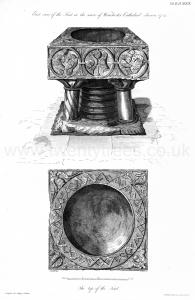
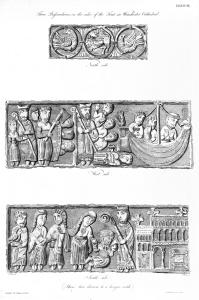
On 18 Mar 1793 Thomas Woods Knollys 7th Earl Banbury (age 65) died. He was buried at Winchester Cathedral [Map]. His son William Knollys 8th Earl Banbury (age 30) de jure 8th Earl Banbury, 7th Viscount Wallingford, 7th Baron Knollys.
In 1807 Thomas Grey 4th Baron Walsingham (age 28) was appointed Archdeacon Winchester.
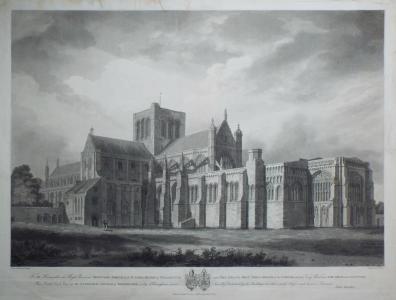 1808. John Buckler (age 37). South East View of the Cathedral Church of Winchester [Map].
1808. John Buckler (age 37). South East View of the Cathedral Church of Winchester [Map].
After 05 Jan 1816. Memorial to Lieutenant-General Sir George Prévost 1st Baronet (deceased) in Winchester Cathedral [Map] sculpted by Francis Leggatt Chantrey (age 34).
Lieutenant-General Sir George Prévost 1st Baronet: On 19 May 1767 he was born. In 1805 Lieutenant-General Sir George Prévost 1st Baronet was created 1st Baronet Prevost of Belmont in Hampshire. On 05 Jan 1816 Lieutenant-General Sir George Prévost 1st Baronet died. His son George Prévost 2nd Baronet succeeded 2nd Baronet Prevost of Belmont in Hampshire.
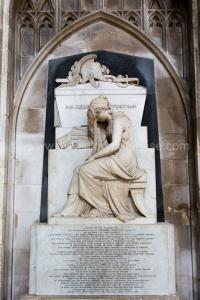
On 18 Jan 1817 Jane Austen (age 41) died. Memorial in Winchester Cathedral [Map].
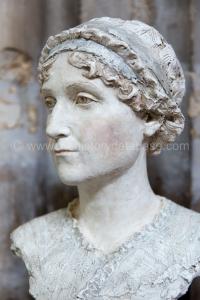
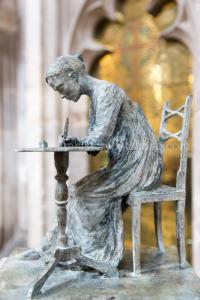
In 1819 Augustus George Legge (age 45) was appointed Archdeacon Winchester.
Before 18 Aug 1825 Charles Augustus North (age 40) was appointed Prebendary of Winchester.
In 1827 Bishop Charles Richard Sumner was appointed Bishop of Winchester.
Before 1835 William Garnier was appointed Prebendary of Winchester.
In 1840 Thomas Garnier (age 64) was appointed Dean of Winchester.
In 1895 Bishop Randall Davidson (age 46) was elected Bishop of Winchester.
On 02 Jun 1908 General Redvers Henry Buller VC (age 68) died at Downes House Downes Crediton, Devon. He was buried in the Church of the Holy Cross Crediton, Devon [Map]. Memorial in Winchester Cathedral [Map] sculpted by Bertram Mckennal (age 44).
General Redvers Henry Buller VC: On 07 Dec 1839 he was born to James Wentworth Buller and Charlotte Juliana Jane Howard-Molyneux-Howard in Downes Crediton, Devon. In 1882 General Redvers Henry Buller VC and Audrey Jane Charlotte Townshend were married. She the daughter of John Townshend 4th Marquess Townshend and Elizabeth Jane Stuart.
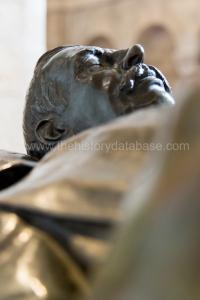
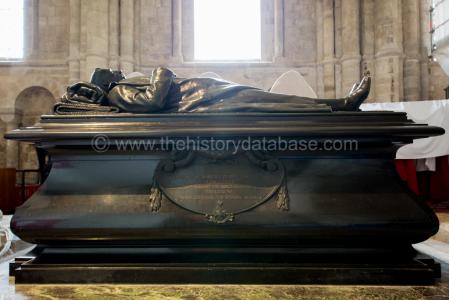
On 15 Sep 1952 Very Reverend Frederic Athelwold Iremonger (age 74) died. Memorial in Winchester Cathedral [Map] sculpted by Bertram Mckennal.
Very Reverend Frederic Athelwold Iremonger: On 08 Jul 1878 he was born to William Henry Iremonger and Mary Sophia Iremonger.
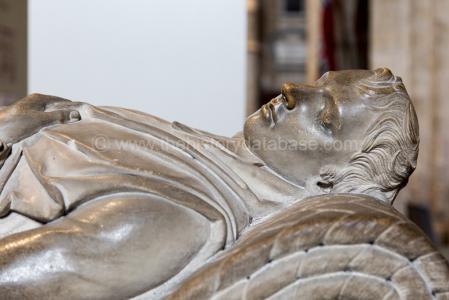
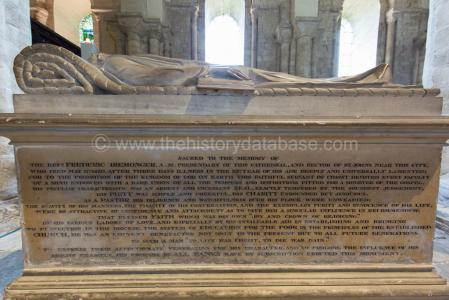
Monumental Effigies. Athelmar, or Aymer, de Valence, Bishop of Winchester, died 1261, in Winchester Cathedral [Map].
Bishop Aymer de Valence:
Around 1222 he was born to Hugh Lusignan X Count Lusignan V Count La Marche and Isabella of Angoulême Queen Consort England.
In 1240 he was appointed Bishop of Winchester.
On 05 Dec 1250 Bishop Aymer de Valence died at Paris.
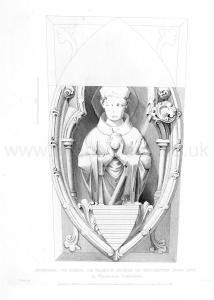
Bede. "In the name of our Lord God and Saviour Jesus Christ, who reigns for ever and for ever, and governs his church, it was thought meet that we should assemble, according to the custom of the venerable canons, to treat about the necessary affairs of the church. We met on the 24th day of September, the first indiction, at a place called Hertford, Hertfordshire [Map], myself, Theodore, the unworthy bishop of the see of Canterbury, appointed by the Apostolic See, our fellow-priest and most reverend brother, Bisi, bishop of the East Angles; also by his proxies, our brother and fellow-priest, Wilfrid, bishop of the nation of the Northumbrians, as also our brothers and fellow priests, Putta, bishop of the Kentish castle, called Rochester; Eleutherius, bishop of the West Saxons, and Winfrid, bishop of the province of the Mercians. When we were all met together, and were sat down in order, I said, ' I beseech you, most dear brothers, for the love and fear of our Redeemer, that we may all treat in common for our faith; to the end that whatsoever has been decreed and defined by the holy and revered fathers, may be inviolably observed by all.' This and much more I spoke tending to the preservation of the charity and unity of the church; and when I had ended my discourse, I asked every one of them in order, whether they consented to observe the things that had been formerly canonically decreed by the fathers ? To which all our fellow-priests answered, ' It so pleases us, and we will all most willingly observe with a cheerful mind whatever is laid down in the canons of the holy fathers.' I then produced the said book of canons, and publicly showed them ten chapters in the same, which I had marked in several places, because I knew them to be of the most importance to us, and entreated that they might be most particularly received by them all.